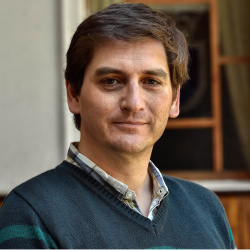Adjunct Researcher at Centro Interdisciplinario de Neurociencia de Valparaíso.
Full Professor at Faculty of Sciences, Universidad de Valparaíso.
Director of Biophysics and Computational Biology PhD Program at University of Valparaíso.
PhD in Sciences, mention in Molecular, Cellular Biology and Neurosciences. Universidad de Chile (2004)
Curriculum Vitae – Google Scholar –  ORCID – ResearcherID
ORCID – ResearcherID
Contact Information:
E-Mail: patricio.orio@uv.cl
Pasaje Harrington 287, Playa Ancha. Valparaíso
Phone: (56)-(32)-2508040
Mathematical Modelling of Neuron Behavior
Neurons and neural networks show a complex behavior due to the high non-linearity of their responses to different stimuli. Much of what we currently understand about this behavior has come from the mathematical modeling of the different processes taking place in the cell membrane. The analysis of dynamical systems that arise from the physical and chemical principles underlying the transmission of electrical signals in living organisms, has been a great aid in the understanding of experimental data, and is also a whole research field on its own.
My current research interests include:
-
- How neural dynamics and network topology can shape the dynamics of a neural network. The dynamics of networks in the brain show unique features, like the ability to engage in different types and degrees of synchrony and the jumping between several stable attractrors -known as multistability. How these properties arise from the different properties of a network? I am interested in two particular features:
- Chaotic behavior of neural oscillators. Individual networks and neural circuits, like many other high-dimensional systems, show a behavior known as chaos. This consists in a high sensitivity to initial conditions, where two systems starting at very close initial conditions diverge exponentially in time. Is this property of the individual nodes relevant to the network behavior?
- Network topology . The topology of neural networks show distinct features, such as being scale-free and showing small-world properties. At the same time, they are different from other typical small-world networks. Which features of the network topology determine or contribute to the multistability of a network?
- How neural dynamics and network topology can shape the dynamics of a neural network. The dynamics of networks in the brain show unique features, like the ability to engage in different types and degrees of synchrony and the jumping between several stable attractrors -known as multistability. How these properties arise from the different properties of a network? I am interested in two particular features:
-
- How sensory systems detect complex features of the environment:
- Understanding the dynamic response of cold-sensitive nerve terminals. Cold receptors in our skin and peripheral tissues display a exquisite sensitivity to changes in temperature. At the same time, they have a spontaneous, rhythmic activity of action potential generation that appears to follow an ongoing sub-threshold oscillation of the membrane potential. Based on previous models that were focused on the oscillatory pattern generation, we developed a model that reproduces both aspects of the response of cold-sensitive nerve endings, by taking into account recent experimental findings. Currently we are using this model to understand the abnormal behavior of these terminals in pathological conditions such as cold allodynia and hypersensitivity to cold. This is in collaboration with Dr. Rodolfo Madrid (USACH)
- Modeling of the neural networks in the retina, in collaboration with Dr. Adrián Palacios. My interest in this initiative is to develop and analyze conductance-based models of the Starburst Amacrine Cells network in the retina and their role in the direction selectivity of some ganglion cells.
- Channel noise in neurons: Through mathematical modeling and analysis, we want to understand the diverse effects that ion channel stochasticity has on neural excitability.
- How sensory systems detect complex features of the environment:
- Coronel-Oliveros C, Cofré R, Orio P (2021) Cholinergic neuromodulation of inhibitory interneurons facilitates functional integration in whole-brain models. PLoS Comput Biol 17(2): e1008737. https://doi.org/10.1371/journal.pcbi.1008737
- Castro S, El-Deredy W, Battaglia D, Orio P (2020) Cortical ignition dynamics is tightly linked to the core organisation of the human connectome. PLoS Comput Biol 16(7): e1007686. https://doi.org/10.1371/journal.pcbi.1007686
- Piña R, Ugarte G, Campos M, Íñigo-Portugués A, Olivares E, Orio P, Belmonte C, Bacigalupo J & Madrid R (2019). Role of TRPM8 Channels in Altered Cold Sensitivity of Corneal Primary Sensory Neurons Induced by Axonal Damage. J Neurosci 39, 8177–8192. doi: 10.1523/JNEUROSCI.0654-19.2019
- Orio, P., Gatica, M., Herzog, R., Maidana, J. P., Castro, S., & Xu, K. (2018). Chaos versus noise as drivers of multistability in neural networks. Chaos: An Interdisciplinary Journal of Nonlinear Science, 28(10), 106321. doi:10.1063/1.5043447
- Xu K., Maidana JP, Caviedes M, Quero D, Aguirre P and Orio P. (2017). Hyperpolarization-activated current induces period-doubling cascades and chaos in a cold thermoreceptor model. Front. Comput. Neurosci. 11:12.
doi: 10.3389/fncom.2017.00012 - Olivares E, Salgado S, Maidana JP, Herrera G, Campos M, Madrid R and Orio P (2015). TRPM8-dependent dynamic response in a mathematical model of cold thermoreceptor. PLOS One 588(Pt 17):3141-8 doi: 10.1371/journal.pone.0139314
- Pezo D, Soudry D and Orio P (2014) Diffusion approximation-based simulation of stochastic ion channels: which method to use? Front. Comput. Neurosci. 8:139. doi:10.3389/fncom.2014.00139



